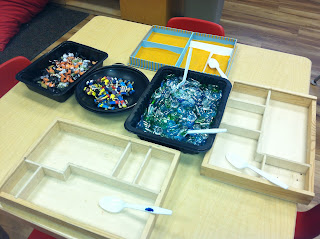What is a planned environment?
It’s a place that
invites you in, that calls out “I’m ready for you.” “I’m waiting for you.” “I
have what you need.” It’s why we are drawn to closet and storage organization
stores, and why we feel more comfortable in a shop where items are organized
and displayed carefully than one where items are randomly crowded together.
When a space is designed with our needs in mind and invites us in, we feel
comfort and serenity. When a space seems disordered and unwelcoming, we feel
unhappiness and confusion.
Planned environments give us the support we need to do
work in our everyday lives. We often don’t appreciate this until we don’t have
it – the moment of reaching into a cluttered drawer to search for a working
pen, or buying food at a lunch counter and not seeing a place to sit down.
Children need that support too. A planned environment, where the materials they
need to work and play are carefully chosen, organized, displayed, and presented
helps them do the rich learning of problem solving, planning, inventing, and
figuring things out.
Planned environments also help set the emotional stage for separating from parents each day and coming to school. From the first step into the classroom, children can feel a connection with the teachers as people who invited them in, and who made them feel welcome. As adults, we feel this way when we walk into a meeting and there’s a pitcher of water and a bowl of snacks on the table, and enough chairs for everyone who is attending. We get the warm feeling, “They’re expecting me, and they got things ready for me.” That’s the same feeling that children should have when they walk into school.
A planned environment might involve:
- Arranging materials in a visually appealing way:
- Arranging areas so multiple children have the space
and materials they need to work:
- Choosing materials with thought and intention for how they will be used and how children will interact while using them:
- Storing and displaying items in ways that allow
children to easily find what they need.
When teachers anticipate and plan for what children
will need to do their work, children are better able to do their work with
engagement, purpose, independence, and competence.









No comments:
Post a Comment